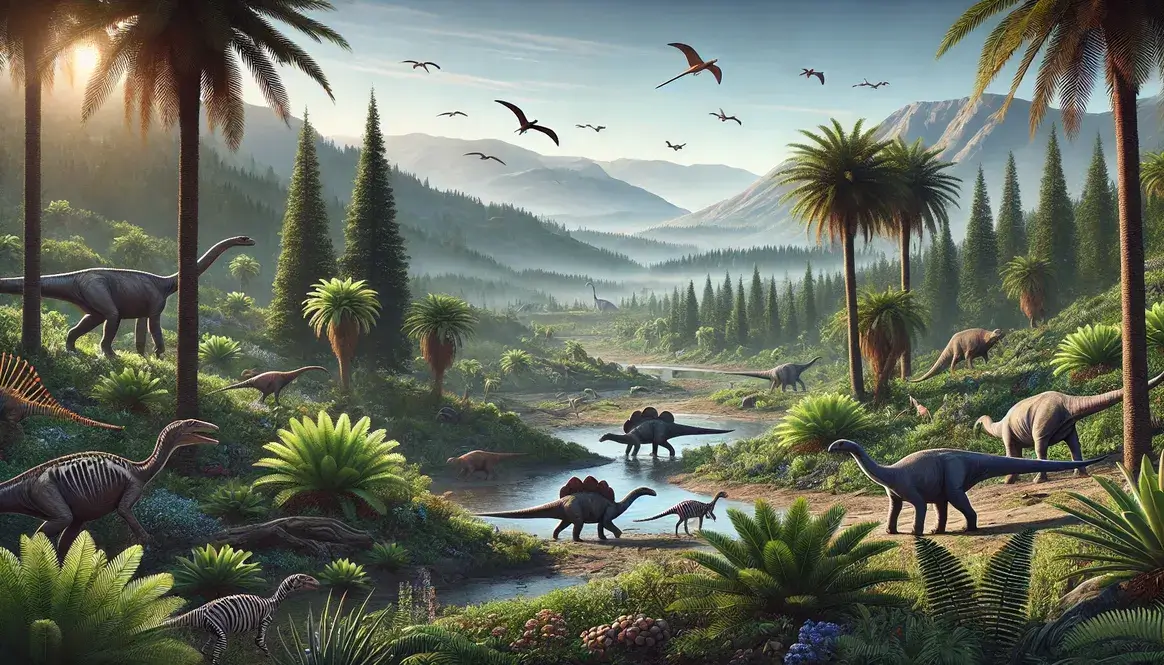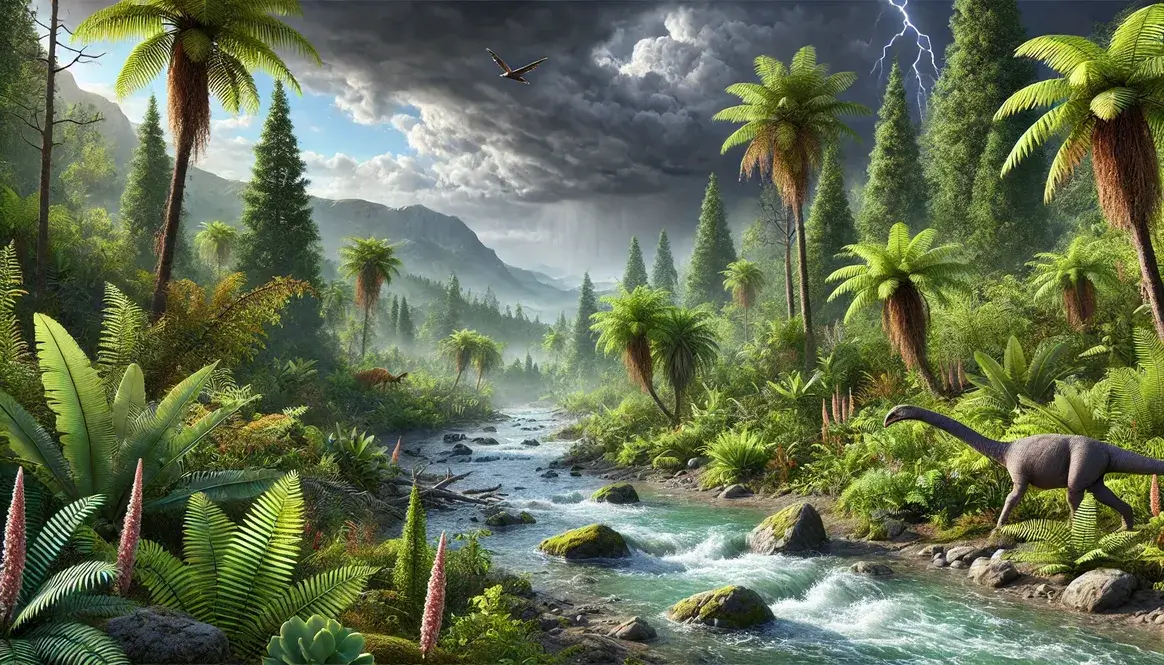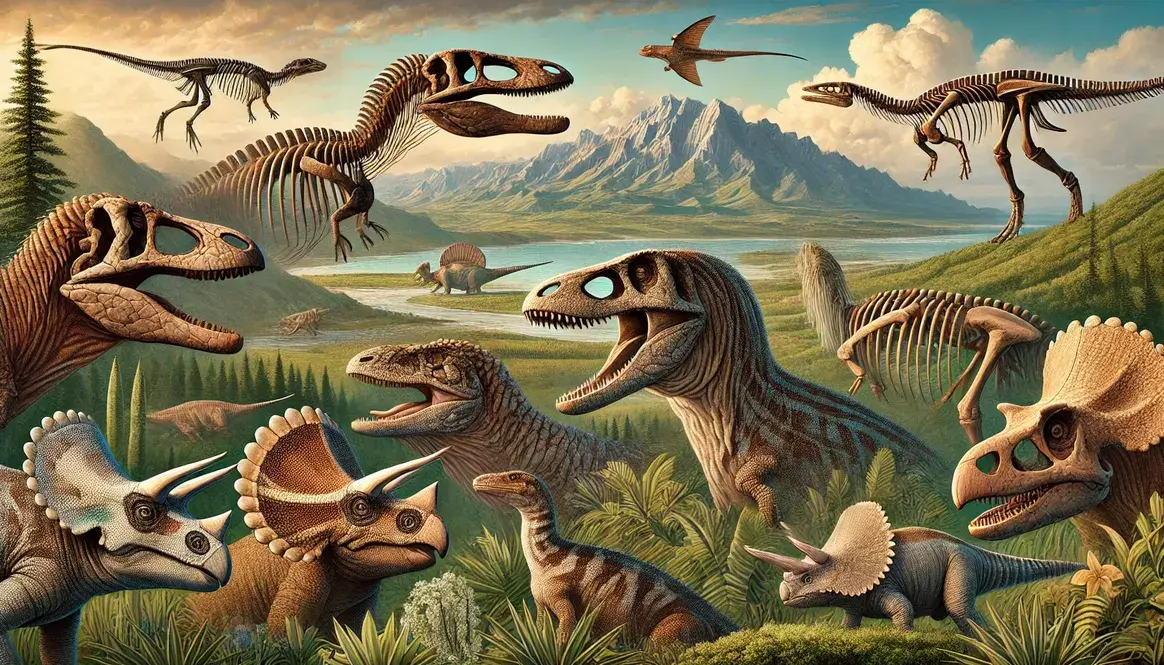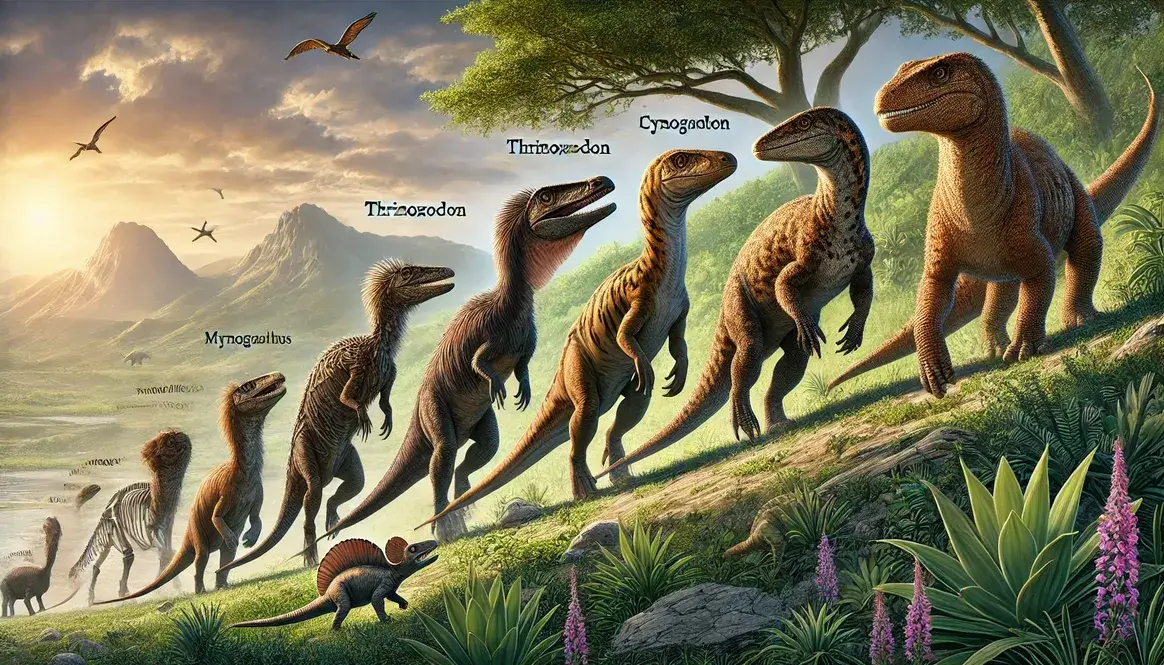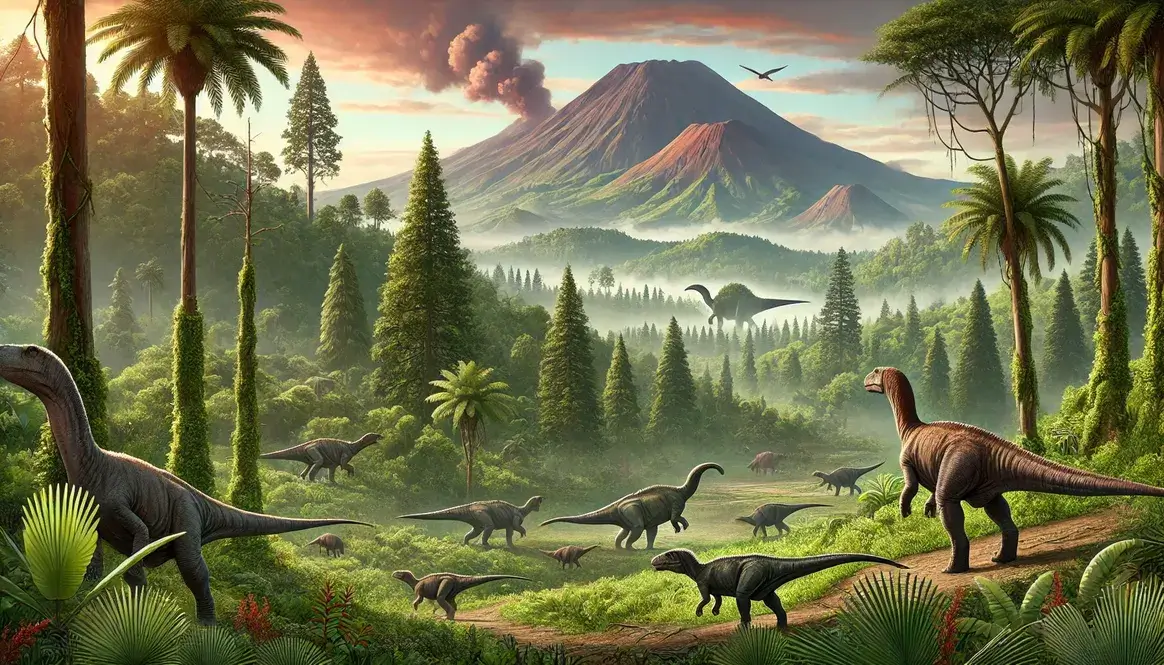Picture a world 252 million years ago. The Triassic period had just begun, marking the start of the Mesozoic Era. This time in Earth’s history was crucial, as it set the stage for the rise of dinosaurs and the reshaping of our planet’s landscapes.
The Triassic lasted about 50 million years, from 252 to 201 million years ago. It was a time of great change and recovery, following the largest mass extinction event in Earth’s history. This period saw the birth of new species, the formation of massive landscapes, and the beginnings of the world we know today.
Early Triassic: A World Recovering from Mass Extinction
The Early Triassic was a time of recovery and adaptation. Life on Earth was slowly bouncing back from the devastating Permian-Triassic extinction event, which had wiped out a staggering 95% of marine species and 70% of terrestrial vertebrate species. The planet was in a state of flux, with harsh conditions challenging the survivors.
Pangaea: The Supercontinent Takes Shape
As the Triassic began, Earth looked very different from today. All the continents were squished together into one giant landmass called Pangaea. Imagine being able to walk from what is now North America all the way to Africa without crossing an ocean!
Pangaea was shaped like a big ‘C’, with a vast ocean called Panthalassa surrounding it. This setup had a huge impact on the planet’s climate and ecosystems:
- The interior of Pangaea was extremely dry and hot.
- Coastal areas experienced more moderate temperatures and rainfall.
- Ocean currents flowed differently, affecting global weather patterns.
Barren Landscapes and Harsh Conditions
The Early Triassic world was a tough place to live. The landscape was mostly barren, with few plants and animals.
| Characteristic | Early Triassic Condition |
|---|---|
| Plant life | Sparse, mostly ferns and mosses |
| Animal life | Few survivors, mostly small reptiles |
| Climate | Hot and dry, with extreme seasons |
| Oxygen levels | Lower than today |
Surviving species faced numerous challenges:
- Intense heat and drought in many areas
- Limited food sources
- Competition for resources
- Adapting to new environmental conditions
Despite these hardships, life found a way to persist and eventually thrive. The harsh Triassic climate played a crucial role in shaping the evolution of species during this time.
Middle Triassic: Life Begins to Flourish
As the Triassic progressed, the planet began to show signs of recovery. The Middle Triassic marked a turning point, with life forms adapting to their new environments and evolving to fill empty ecological niches.
Continental Drift: The First Signs of Breakup
As the Triassic progressed, Pangaea began to show signs of breaking apart. This process, known as continental drift, had significant effects on the planet:
- Formation of rift valleys and shallow seas
- Creation of new habitats and ecosystems
- Changes in regional climates
These changes provided opportunities for life to diversify and adapt to new environments. The shifting continents would eventually lead to the diverse geography we see today.
Evolving Ecosystems: New Niches Emerge
With the gradual breakup of Pangaea and the recovery of life forms, the Middle Triassic saw a boom in biodiversity. Plants and animals began to fill new ecological niches:
- Plants: Conifers and cycads became more common, creating new forest habitats. Triassic plants played a crucial role in shaping the emerging ecosystems.
- Marine life: Fish and marine reptiles diversified, populating the seas. The Triassic seas became home to a variety of fascinating creatures.
- Land animals: Early dinosaurs and crocodile-like reptiles emerged. These early forms would eventually give rise to the diverse array of Triassic dinosaurs.
This period set the stage for the more familiar Triassic landscapes and creatures we often think of when imagining this ancient world. The planet was transforming from a barren wasteland into a thriving, diverse ecosystem.
As life flourished, complex food webs began to form, laying the groundwork for the rich ecosystems of the Late Triassic and beyond.
Late Triassic: The Age of Reptiles Begins
The Late Triassic, spanning from about 237 to 201 million years ago, marked a turning point in Earth’s history. This period saw reptiles rise to dominance, setting the stage for the Age of Dinosaurs.
Pangaea at its Peak: A World of Extremes
Pangaea reached its fullest extent during the Late Triassic, creating a world of stark contrasts. The heart of this supercontinent was a vast, scorching desert stretching thousands of miles, while coastal regions enjoyed milder climates with more abundant rainfall.
This unique continental arrangement profoundly affected global climate:
- Extreme seasonality in the interior
- Intense monsoons along the coasts
- Limited ocean circulation, impacting global heat distribution
The contrast between inland and coastal environments was striking:
| Region | Climate | Characteristics |
|---|---|---|
| Pangaea Interior | Hot, arid | Vast deserts, extreme temperatures |
| Coastal Areas | Mild, humid | Lush forests, abundant rainfall |
Dinosaurs Take Center Stage
The Late Triassic witnessed the emergence of true dinosaurs. These early forms, generally small and bipedal, quickly began to diversify. Early dinosaurs like the meat-eating Coelophysis and the long-necked Plateosaurus appeared during this time.
While dinosaurs made their debut, other reptile groups also thrived in the Triassic world:
- Pterosaurs took to the skies as the first flying vertebrates
- Crocodylomorphs, ancestors of modern crocodiles, diversified
- Marine reptiles like ichthyosaurs and plesiosaurs ruled the Triassic seas
Triassic Atmosphere: A Different Kind of Air
The Triassic atmosphere differed significantly from what we breathe today, playing a crucial role in shaping the planet’s climate and life forms.
Composition and Climate
Triassic air was thick with greenhouse gases, with CO2 levels 5-10 times higher than present-day levels. Oxygen content, however, was lower, around 15% compared to our current 21%. These atmospheric conditions led to global warming, enhanced plant growth, and posed challenges for animal life due to lower oxygen levels.
Temperature trends throughout the Triassic showed a general warming pattern:
- Early Triassic: Hot and inhospitable
- Middle Triassic: Gradual cooling and stabilization
- Late Triassic: Warm but more moderate than the early period
Extreme Weather Patterns
The Triassic climate was characterized by intense and often unpredictable weather. Mega-monsoons brought heavy rains to coastal areas, while inland regions experienced prolonged droughts. The warm climate fueled powerful storm systems, creating a dynamic and challenging environment for life.
Regional variations across Pangaea were stark. Equatorial regions remained hot and humid with year-round rainfall. Mid-latitudes experienced seasonal extremes, alternating between wet and dry periods. Even polar regions were warmer than today, though still experiencing seasonal darkness.
The Triassic climate played a crucial role in shaping the evolution and distribution of life forms. These extreme conditions tested the adaptability of species, driving the development of new traits and behaviors that would define life in the Mesozoic era.
Triassic Oceans: Life Beneath the Waves
The Triassic seas were a world of renewal and innovation, teeming with life that had evolved to fill the ecological gaps left by the Permian extinction.
Marine Ecosystems Recover and Thrive
After the devastating Permian extinction, marine life made a remarkable comeback during the Triassic. This recovery wasn’t just about numbers – it was about innovation and adaptation.
Key players in the Triassic oceans included:
- Ammonites: These shelled cephalopods diversified rapidly, becoming important predators and prey.
- Bony fish: New groups emerged, laying the foundation for modern fish diversity.
- Reef builders: Corals and sponges began to construct new reef ecosystems.
The rebound of marine life created complex food webs, setting the stage for the evolution of larger predators.
The Rise of Marine Reptiles
The Triassic period saw an explosion of reptilian life in the oceans. These marine reptiles evolved from land-dwelling ancestors, adapting to life in the water with remarkable speed.
- Ichthyosaurs: These “fish lizards” evolved streamlined, dolphin-like bodies perfect for pursuing prey.
- Plesiosaurs: With long necks and paddle-like limbs, they became efficient hunters in shallow seas.
- Nothosaurs: These semi-aquatic reptiles were among the first to venture into the water.
The arrival of these new predators reshaped ocean food webs. Smaller fish and invertebrates faced new pressures, while the marine reptiles competed among themselves for dominance of different oceanic niches.
Triassic Landscapes: A Changing World
On land, the Triassic world was a place of stark contrasts and rapid change.
From Deserts to Lush Forests
Pangaea’s vast expanse hosted a variety of biomes:
| Biome | Location | Characteristics |
|---|---|---|
| Hot deserts | Interior | Extreme heat, minimal vegetation |
| Temperate forests | Mid-latitudes | Diverse plant life, seasonal changes |
| Tropical rainforests | Equatorial regions | Dense vegetation, high biodiversity |
The evolution of Triassic plant life had a profound impact on terrestrial ecosystems:
- Conifers became dominant in many areas, providing new habitats for animals.
- Cycads and ginkgoes added to the diversity of forest ecosystems.
- The first flowering plants appeared late in the period, though they wouldn’t dominate until later.
These changes in vegetation influenced the evolution of herbivorous animals and their predators, shaping the course of terrestrial life.
The First Mammals: Small But Significant
While reptiles dominated the Triassic landscape, the first mammals were making their humble debut. These early mammals, evolved from mammal-like reptiles called cynodonts, were small but significant players in the Triassic ecosystem.
Early mammals occupied various ecological niches:
- Insectivores: Many early mammals likely fed on the abundant insects of the Triassic.
- Burrowers: Some species adapted to underground life, safe from large predators.
- Nocturnal creatures: Many early mammals may have been active at night, avoiding competition with diurnal reptiles.
Though small, these early mammals were laying the groundwork for the mammalian dominance that would come much later, after the age of dinosaurs.
The End of an Era: Transition to the Jurassic
The Triassic period came to a dramatic close with another mass extinction event about 201 million years ago. This event, while not as severe as the Permian extinction, still had a significant impact on life on Earth.
Key aspects of the end-Triassic extinction include:
- Massive volcanic eruptions, likely tied to the breakup of Pangaea
- Sudden climate change and ocean acidification
- Extinction of many marine reptiles and amphibians
Despite the devastation, this event cleared the way for the rise of dinosaurs in the Jurassic period. The end-Triassic extinction set the stage for the next chapter in Earth’s history, where dinosaurs would truly come to dominate the planet.

